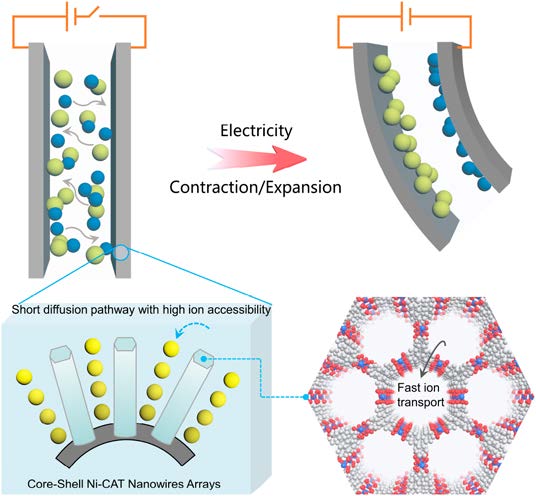新闻动态

- 地址: 江苏省苏州市苏州工业园区若水路398号
- 邮箱: tzhang2009@sinano.ac.cn
- 电话: 86-512-62872706
- 传真: 0512-62603079
- 网址: http://nanosensor.sinano.ac.cn

祝贺课题组史意祥博士“Soft Electrochemical Actuators with a Two-Dimensional Conductive Metal–Organic Framework Nanowire Array”文章被Journal of the American Chemical Society接收
Yixiang Shi; Yue Wu; Shuqi Wang; Yangyong Zhao; Tie Li; Xianqing Yang; Ting Zhang*; Soft Electrochemical Actuators with a Two-Dimensional Conductive Metal–Organic Framework Nanowire Array, Journal of the American Chemical Society, 2021, DOI: 10.1021/jacs.1c00666.
ABSTRACT: Electrically activated soft actuators capable of large deformation are powerful and broadly applicable in multiple fields. However, designing soft actuators that can withstand a high strain, provide a large actuation displacement, and exhibit stable reversibility are still the main challenges toward their practical application. Here, for the first time, we report a twodimensional (2D) conductive metal−organic framework (MOF) based electrochemical actuator, which consists of vertically oriented and hierarchical Ni-CAT NWAs/CNF electrodes through the use of a facile one-step in situ hydrothermal growth method. The soft actuator prepared in this study demonstrated improvements in actuation performance and benefits from both the intrinsically ordered porous architecture and efficient transfer pathways for fast ion and electron transport; furthermore, this actuator facilitated a considerably high diffusion rate and low interfacial resistance. In particular, the actuator demonstrated a rapid response (<19 s) at a 3V DC input, large actuation displacement (12.1 mm), and a correspondingly high strain of 0.36% under a square-wave AC voltage of ±3 V. Specifically, the actuator achieved a broad-band frequency response (0.1−20 Hz) and long-term cyclability in air (10000 cycles) with a negligible degradation in actuation performance. Our work demonstrates new opportunities for bioinspired artificial actuators and overcomes current limitations in electrode materials for soft robotics and bionics.





